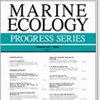Marine biophysical conditions influence the vertical and horizontal distribution of sub-adult Chinook salmon in nearshore marine waters
IF 2.1
3区 环境科学与生态学
Q2 ECOLOGY
引用次数: 0
Abstract
ABSTRACT: The present study quantified the vertical and horizontal distribution of sub-adult Chinook salmon Oncorhynchus tshawytscha in nearshore marine environments. Depth-specific hook and line sampling was conducted along the Pacific Ocean coast of Washington, USA. Our analysis, based on 187 Chinook salmon from 1299 sampling deployments and 6616 hooks, revealed a wide distribution of salmon in nearshore marine waters, with distinct patterns associated with fish size and age. Chinook salmon that spent one winter in marine waters were more likely to be caught at greater depths than those in their first year at sea, and larger fish were found at greater depths than smaller fish. The probability of Chinook salmon capture varied with depth, showing a higher likelihood of capture at midwater (>15 m from the surface and >5 m from the bottom) and near (<5 m) the bottom compared to near (<15 m) the surface. Additionally, environmental variables such as sea surface temperature, sea surface chlorophyll a, minutes to low tide, and boat speed unimodally influenced capture probability. Our study contributes valuable insights into the spatiotemporal ecology of Chinook salmon, offering a more mechanistic perspective for their management and conservation. The identified relationships between environmental covariates and Chinook salmon distribution can be used to inform life cycle models used to manage and protect this at-risk species and the ecosystem processes that depend on them, particularly in the context of changing oceanic conditions and their role as both predator and prey in marine ecosystems.海洋生物物理条件影响亚成体大鳞大麻哈鱼在近岸海域的垂直和水平分布
摘要:本研究对近岸海洋环境中亚成体大鳞大麻哈鱼(Oncorhynchus tshawytscha)的垂直和水平分布进行了量化。研究人员在美国华盛顿州太平洋沿岸进行了特定深度的钩线取样。我们根据 1299 次采样部署和 6616 个鱼钩采集到的 187 条大马哈鱼进行了分析,结果显示大马哈鱼在近岸海洋水域的分布范围很广,与鱼体大小和年龄相关的模式也很明显。与第一年出海的大马哈鱼相比,在海洋水域中度过一个冬季的大马哈鱼更有可能在更深的水域中被捕获,而且较大的鱼比较小的鱼在更深的水域中被发现。大鳞大麻哈鱼被捕获的概率随深度而变化,在中层水域(距海面 15 米和距海底 5 米)和靠近海底(5 米)捕获的概率高于靠近海面(15 米)捕获的概率。此外,海面温度、海面叶绿素 a、退潮时间和船速等环境变量也会对捕获概率产生单向影响。我们的研究为大鳞大麻哈鱼的时空生态学提供了宝贵的见解,为其管理和保护提供了更多的机制视角。所确定的环境协变量与大鳞大麻哈鱼分布之间的关系可用于建立生命周期模型,以管理和保护这一濒危物种以及依赖它们的生态系统过程,特别是在海洋条件不断变化的背景下,以及它们在海洋生态系统中既是捕食者又是猎物的角色。
本文章由计算机程序翻译,如有差异,请以英文原文为准。
求助全文
约1分钟内获得全文
求助全文
来源期刊

Marine Ecology Progress Series
环境科学-海洋学
CiteScore
5.30
自引率
8.00%
发文量
238
审稿时长
3 months
期刊介绍:
The leading journal in its field, MEPS covers all aspects of marine ecology, fundamental and applied. Topics covered include microbiology, botany, zoology, ecosystem research, biological oceanography, ecological aspects of fisheries and aquaculture, pollution, environmental protection, conservation, and resource management.
 求助内容:
求助内容: 应助结果提醒方式:
应助结果提醒方式:


